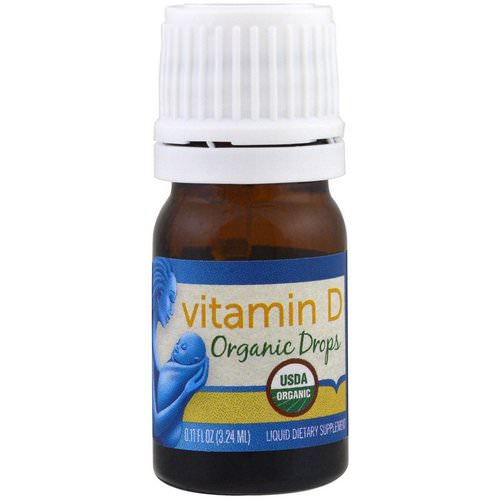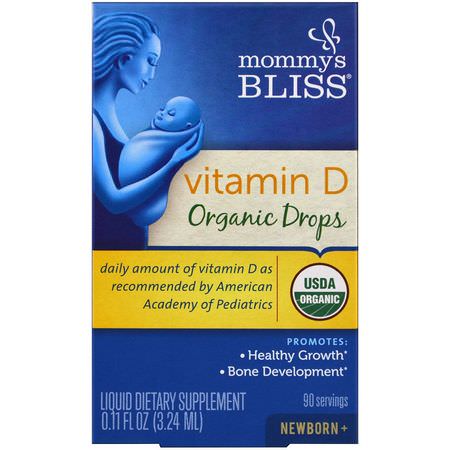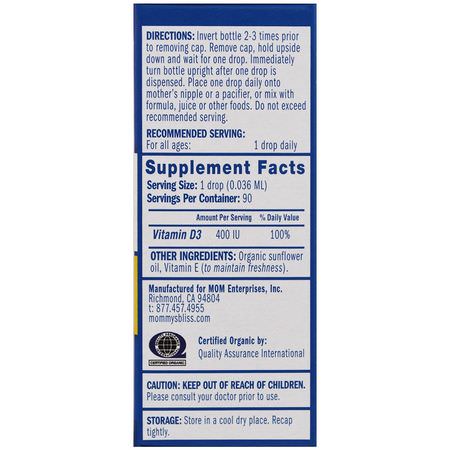Foodpharmacy Blog: Kids, Baby, Children's Health, Children's Vitamin D
Mommy’s Bliss, Vitamin D, Organic Drops, Newborn +, 0.11 fl oz (3.24 ml)

$9.60
Product name: Mommy’s Bliss, Vitamin D, Organic Drops, Newborn +, 0.11 fl oz (3.24 ml)
Quantity: 0.11 fl oz, 0.05 kg, 9.7 x 5.8 x 5.8 cm
Categories: Mommy’s Bliss, Baby, Kids, Children’s Health, Children’s Vitamin D, USDA Organic, Certified Organic, No Artificial Flavors, Dairy Free, Casein Free
USDA Organic, Liquid Dietary Supplement, 90 Servings, Certified Organic by: Quality Assurance International, No Additives, Chemicals or Parabens, No Artificial Flavors or Colors, No Dairy, Gluten or Soy, Promotes: Healthy Growth, Bone Development, Daily amount of vitamin D as recommended by American Academy of Pediatrics, Mommy’s Bliss Vitamin D Organic Drops provide the recommended amount of vitamin D for healthy growth and development for babies who are breastfed, Contains 400 IU of vit. D per Serving, Only one drop per day, Does not require refrigeration, Our Story, Our family-run company was founded by my mom, who raised three children while working as a registered nurse, lactation consultant and certified nurse midwife. Driven by compassion, she created Mommy’s Bliss to safely and naturally bring families back to wellness, Yasmin K, Daughter and CEO.

Gummies are fun and make getting your kids to take vitamins easier, but the doctors suggest you think twice. The lack of data and the risks associated with prolonged sun exposure suggest food and supplementation as the preferred mode of repleting vitamin d stores. Too much vitamin d can cause calcium to accumulate in your blood, which can damage your heart, blood vessels, and kidneys. Mayo clinic offers appointments in arizona, florida and minnesota and at mayo clinic health system locations. 1 Rickets may be caused by reasons other than nutritional vitamin d deficiency (E. The findings from this study indicated that around half of the parents reported receiving no information about vitamin d during pregnancy, breastfeeding or for their child. Dosing recommendations for children younger than 5 years old are vitamin d 2 12,000 units biweekly, and 50,000 units weekly or biweekly of vitamin d 2 for those 5 years and older. Omega 3s are crucial for healthy brain development which is especially important at a young age. We also consider the number of additional active ingredients because lesser-known nutrients, such as choline, inositol, and lycopene have well documented health benefits, but are typically not included in the more basic multivitamin formulations. Practices and preferences for vitamin d supplementation of their infants in primary care. How to incorporate vitamin d into a daily routine, with clear instructions on how to give a baby or child vitamin d supplementation. These vitamins and minerals can help growth and development of bones, teeth, muscles, and tissue.
Mommy’s Bliss, Vitamin D, Organic Drops, Newborn +, 0.11 fl oz (3.24 ml): Children’s Vitamin D, Children’s Health, Kids, Baby
Vitamin a is important for babies and young children, and some may not be getting enough. Adolescents who do not get 600 iu of vitamin d per day through foods should receive a supplement containing that amount. A big seller these days is vitamin d; a recent report concluded that vitamin d deficiencies may cause hypocalcemic seizures, growth disturbances and rickets and perhaps influence cardiovascular disease, diabetes and cancer. To help your kid eat more produce, continually introduce new veggies and fruits prepared in different and tasty ways. Excessive consumption of vitamin d can lead to over calcification of bones and the hardening of blood vessels, kidney, lung, and heart tissues. 25(Oh)d, though metabolically inactive, is the major circulating from of vitamin d. Exclusive breastfeeding without adequate sun exposure or vitamin d supplementation contributes to ongoing vitamin d deficiency in newborns as unsupplemented breast milk only contains 20 to 80 iu/l of vitamin d. Many parents had not been informed why they need to take a vitamin d supplement and the importance of vitamin d for their baby/child was not made clear. What is not controversial is the importance of eradicating nr and other severe vitamin d deficient conditions in pediatric populations. There was evidence that the recommendations for vitamin d were not being followed by pregnant or breastfeeding women or parents, as levels of vitamin d supplementation were lower than they should be.

Will continue to give these to all three kids through the sick months and will reevaluate. Vitamin d and calcium are essential for adequate health throughout the lifespan. 24 Currently, there are no recommendations available to validate the appropriate duration of sun exposure in the pediatric population, and the variability of vitamin d synthesis between individuals would make such a recommendation difficult. People low in vitamin d who take a supplement may be less likely to fall. Generally speaking, levels of at least 30 ng/ml (75 Nmol/l) appear safe and reasonable for children with chronic disease, and additional research is confirming whether this range is appropriate for other pediatric groups as well. In our modern society, many factors contribute to the likeihood that we do not have enough vitamin d: We do not go outside, sunblock, shirts, too hot, etc (All of these inhibit vitamin d levels). 8, 31, 51 However, vitamin d 3 is noted as an acceptable alternative. In her experience, kids who drink shakes wind up being even pickier eaters than they were in the first place. Diagram showing the main steps of vitamin d synthesis and metabolism. The accelerated rate of bone development during a child’s life suggests that adequate concentrations of vitamin d are an important issue in this population. Beyond bones, this combo may also help promote healthy nerves, hormones, and teeth.
When i was found to be d deficient i turned to the web and found that most americans are and there are numerous health problems arising from d deficiency! Secondary prevention of vitamin d-deficiency rickets. Multiple studies have linked vdd to adverse health outcomes in both children and pregnant women. The diagnosis, causes, and prevention of vitamin d deficiency in children, and the treatment of vitamin d deficiency in the absence of rickets will be reviewed here. Vitamin d deficiency has been highlighted as a serious public health problem in the united kingdom. Though the role of calcium in suppressing pain could not be ruled out, vitamin d seemingly was more vital for headache relief. The serum concentration that constitutes vitamin d deficiency is controversial and not well supported by clinical trials, especially in the pediatric population. With vitamin d through maternal supplementation or intermittent high-dose vitamin d. Proper vitamin d levels are crucial throughout life but especially during childhood. Parents were generally not aware of the importance of vitamin d, dietary requirements including supplementation and the availability of vitamin d fortified foods. Foods/drinks or sunlight were not discussed by their midwife or health visitor.
Ten thousand three hundred sixty-six children in finland received 2,000 iu of vitamin d daily for the first year of life and then followed for the next 31 years. Vitamin d is essential for calcium absorption and for maintaining bone health in the pediatric population. Overall willingness to purchase certain products fortified with vitamin d was however, high. Six years later, the children were examined by dentists who did not know which mothers had taken the supplements. I spoke with john atwater, senior director of the usp verification programs, to make sure i was not missing anything, and he says established pharmaceutical companies like bayer (Flintstones vitamins) and pfizer (Centrum kids) feel they have enough brand recognition and strong internal protocols to forgo an external audit. Empirical therapy of vitamin d deficiency with high vitamin d doses, such as stoss therapy, is discouraged without previous documentation of 25ohd concentrations and monitoring of 25ohd and serum calcium levels. The most important steps in vitamin d metabolism are shown in figure 1, vitamin d hydroxylation to 25-hydroxyvitamin d (25Ohd) in the liver depends on substrate availability, and therefore, 25ohd concentrations rise in circulation during excess or intoxication. Vitamin d and dental caries in children. Studies have shown that most vitamins, fluoride, iron, water, juice, formula and solid foods are not beneficial to healthy breastfed babies during the first six months, and some can even be harmful.
Mommy’s Bliss Children’s Vitamin D
In a recent series of six infants with vitamin d intoxication, oral alendronate achieved normocalcemia four times faster than steroids. Optimizing bone health and calcium intakes of infants, children, and adolescents. 25Ohd is further hydroxylated in the kidney to the active form 1,25(Oh) 2d in a tightly regulated process. For babies under one year old, it is also highly recommended to use vitamin d drops such as enfamil d-vi-sol, as vitamin d is critical for the proper development of the infant. Two hundred and forty-five healthy infants, aged between 6 and 24 months, followed at two near municipal primary health care units, were invited to participate. Second, i have tried several multivitamins but it did not work with my children because they refused to take any but with this, my problem is solved. One case involved an infant who received a 30-fold overdose of vitamin d when the mother switched over-the-counter formulations from one that contained 400 iu/ml to another that contained 400 iu per drop. Supplementing your child’s diet with a daily multivitamin can be one of the best things you can do for their health. Nutrients that help build bones and promote brain development are especially significant in childhood. Fda requirements for breastfeeding mothers for this vitamin are 120 mg per day (Over 18 years) and 115 mg per day (Under 18 years).
Only 101 (55%) Supplemented their infants with vitamin d. According to the aap, breastfed babies can begin receiving vitamin d supplements in the first few days of life. Products need to be suitable for babies and toddlers, lower costs, with healthy options available; with lower sugar and salt content, tasty, longer shelf life and better availability in local shops and supermarkets. The american academy of pediatrics recommends that fluoride supplements only be given after 6 months, and only to children whose primary water source is deficient in fluoride. Note that gummy vitamins, in particular, can also be easy to overeat. Their asthma symptoms were assessed and serum vitamin d concentrations were obtained. For best results, we recommend choosing a multivitamin product that has an overall effectiveness score of 8,0 and above. Clearly, more extensive longitudinal data are required in both healthy and high-risk children to reinforce long-term use of high-dose vitamin d therapy. The vitamin d epidemic and it’s health consequences. Breastfed babies in particular often need an extra dose of vitamin d, and these baby ddrops make it easy to give it to them.
May be as effective or more effective than giving her baby vitamin supplements. 8 Speak to your pediatrician about the correct dose for your child based on your risk factors. The development of vitamin d deficiency is associated with deteriorating bone health and in severe cases, hypocalcemia, rickets, and osteomalacia in children and adults. The fact that the incidence of upper respiratory illnesses and influenza is higher after the winter solstice, in higher latitudes, in children with rickets, and in the institutionalized again seems to support the theory that the lack of vitamin d increases susceptibility to illness. Journal of paediatrics and child health. The amount of vitamin d in the tablets varied from 9 to 146 percent of what was listed on the bottle. We would like to thank all those who participated in this study, including the parents, health care professionals and early year practitioners who gave up their time to complete a survey or participate in a focus group or interviews.